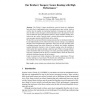Free Online Productivity Tools
i2Speak
i2Symbol
i2OCR
iTex2Img
iWeb2Print
iWeb2Shot
i2Type
iPdf2Split
iPdf2Merge
i2Bopomofo
i2Arabic
i2Style
i2Image
i2PDF
iLatex2Rtf
Sci2ools
CORR
2008
Springer
2008
Springer
Our Brothers' Keepers: Secure Routing with High Performance
The Trinity [1] spam classification system is based on a distributed hash table that is implemented using a structured peer-to-peer overlay. Such an overlay must be capable of processing hundreds of messages per second, and must be able to route messages to their destination even in the presence of failures and malicious peers that misroute packets or inject fraudulent routing information into the system. Typically there is tension between the requirements to route messages securely and efficiently in the overlay. We describe a secure and efficient routing extension that we developed within the I3 [2] implementation of the Chord [3] overlay. Secure routing is accomplished through several complementary approaches: First, peers in close proximity form overlapping groups that police themselves to identify and mitigate fraudulent routing information. Second, a form of random routing solves the problem of entire packet flows passing through a malicious peer. Third, a message authentication ...
| Added | 09 Dec 2010 |
| Updated | 09 Dec 2010 |
| Type | Journal |
| Year | 2008 |
| Where | CORR |
| Authors | Alex Brodsky, Scott Lindenberg |
Comments (0)

